
STUDY OF POLARIZATION DEPENDENT BAND GAPS AND
ANOMALOUS DISPERSION IN HYBRID METAL DIELECTRIC
DOUBLE GYROID STRUCTURES
Nguyen Thi Hien
1*
, Phan Thanh Toan
2
1
Dong Nai Technology University
2
Posts and Telecommunications Institute of Technology
*Corresponding author: Nguyen Thi Hien, nguyenthihien@dntu.edu.vn
1. INTRODUCTION
The gyroid structure, a fascinating three-
dimensional chiral formation, has attracted
considerable attention due to its potential
applications in photonic crystals and meta-
materials (Da et al. 2022). This intricate
structure, first described by Alan Schoen in
1970, is characterized by its unique minimal
surface geometry, which minimizes the surface
area for a given boundary, creating a complex
network of continuous surfaces that separate
space into two interwoven but non-intersecting
GENERAL INFORMATION ABSTRACT
Received date: 26/08/2024 This paper presents a comprehensive study of the optical
properties of a hybrid metal-dielectric double gyroid (DG)
structure, emphasizing its polarization-dependent
characteristics and anomalous dispersion phenomena.
Utilizing finite-difference time-domain (FDTD) simulations,
we investigate the band structure, circular dichroism (CD)
indices, and coupling indices of the hybrid DG to explore the
existence of polarization-specific band gaps and complete
band gaps. Our findings demonstrate that the hybrid DG
exhibits distinct right-handed circularly polarized (RCP) and
left-handed circularly polarized (LCP) band gaps, which can
be finely tuned by adjusting the dielectric refractive index and
the volume fraction of the structure. The study also reveals
high coupling indices for specific modes, indicating efficient
light-matter interaction, which is crucial for the development
of advanced photonic devices such as sensors and optical
filters. Furthermore, we analyze the anomalous dispersion
properties of the hybrid DG, including negative refraction,
which opens possibilities for innovative applications like
superlenses and cloaking devices. These results highlight the
versatility and potential of hybrid metal-dielectric gyroids for
next-generation photonic applications, offering tunable and
customizable optical properties that can be tailored to meet the
demands of various technological domains. The insights
gained from this research provide a deeper understanding of
gyroid-based materials and pave the way for their practical
implementation in sophisticated optical systems.
Revised date: 13/10/2024
Published date: 21/11/2024
KEYWORD
Polarization Band Gaps;
Anomalous Dispersion;
Negative Refraction.
01-2025
42

regions. The periodic and chiral nature of the
gyroid leads to distinctive optical properties,
such as photonic band gaps and circular
polarization-dependent characteristics, making
it an attractive subject for research in photonics
(Liu et al., 2022).
The gyroid structures have been observed
in various natural systems, including the wing
scales of butterflies and the skeletal structures
of certain radiolarians (Marigo, Maurel, Pham,
2023). These natural occurrences highlight the
gyroid's ability to manipulate light in
remarkable ways, which has inspired scientists
to explore its potential for artificial photonic
applications (Zanotto et al. 2022). Photonic
crystals, which are materials that can control
the propagation of light, benefit significantly
from the gyroid's periodic structure, enabling
the creation of materials with complete
photonic band gaps that prohibit the
propagation of light within certain frequency
ranges (Higuera, Miralbes, Ranz, 2022).
Despite the significant progress made in
studying gyroid structures, several key
limitations remain in the existing literature.
First, many studies have focused on gyroid
structures composed of a single material, either
metallic or dielectric, limiting the tunability of
their optical properties. These works, while
foundational, do not fully explore the potential
of hybrid metal-dielectric configurations,
which can offer enhanced control over
polarization-dependent phenomena and
broader photonic band gaps. Additionally, most
prior research has been heavily reliant on
theoretical models and numerical simulations,
with little experimental validation. The absence
of experimental data raises concerns about the
practical applicability of these models in real-
world photonic devices. Furthermore, the
impact of varying material properties such as
dielectric refractive index and volume fraction
has not been extensively studied in hybrid
gyroid structures, leaving a gap in
understanding how these parameters influence
complex phenomena like negative refraction
and anomalous dispersion. By addressing these
gaps, this paper aims to provide a more
comprehensive analysis of hybrid gyroid
structures and offer experimental insights to
support theoretical predictions.
Previous studies have focused primarily on
gyroid structures composed of a single material,
either dielectric or metallic. Dielectric gyroids,
for instance, have been shown to exhibit
complete photonic band gaps when the
refractive index contrast and volume fraction
are appropriately tuned (Holmes et al. 2022).
These structures are useful in applications such
as optical filters, waveguides, and sensors due
to their ability to control light propagation with
minimal losses. On the other hand, metallic
gyroids have been explored for their plasmonic
properties, where the metal's free electrons
interact with light to produce surface plasmon
modes (Lu et al. 2022). These modes can
confine light to very small dimensions,
significantly enhancing light-matter
interactions and enabling applications in areas
like sensing, imaging, and nano-optics
(Teawdeswan and Dong, 2024). The potential
of hybrid metal/dielectric double gyroid
structures remains underexplored. A hybrid
gyroid combines the properties of both metals
and dielectrics, potentially leading to novel
optical phenomena that neither material could
achieve alone. Metals offer high reflectivity and
plasmonic behavior, while dielectrics provide
low-loss propagation and wide band gaps. The
interplay between these materials in a gyroid
structure could result in enhanced optical
properties, such as tailored polarization
responses and tunable band gaps, making
hybrid gyroids promising candidates for
advanced photonic applications. (An et al.,
2023)
In this paper, we investigate the
polarization-dependent characteristics of a
01-2025
43

hybrid metal/dielectric double gyroid using the
finite-difference time-domain (FDTD) method.
This numerical approach allows us to model the
complex interactions between electromagnetic
waves and the gyroid structure with high
precision. We focus on calculating the band
structure, circular dichroism (CD) indices, and
coupling indices to explore the existence and
behavior of polarization band gaps and
complete band gaps in the hybrid system (An et
al., 2023). The CD index provides insight into
the circular polarization properties of the
modes, indicating whether they are right-
handed or left-handed circularly polarized,
while the coupling index measures the degree
of interaction between incident plane waves
and the Bloch modes within the gyroid (Yang
et al., 2020).
We examine how the optical properties of
the hybrid gyroid evolve with different material
fractions, providing a comprehensive analysis
of how variations in the volume fraction and
refractive index of the dielectric component
affect the band gaps (Chouhan, Bala Murali,
2024). By mapping the gap frequencies as
functions of these parameters, we can identify
trends and design principles for optimizing the
hybrid gyroid's optical performance.
Furthermore, we explore the anomalous
dispersion characteristics of the hybrid gyroid,
such as negative refraction, which occurs when
the refracted light beam bends in the opposite
direction to what is normally expected. This
phenomenon is investigated through equi-
frequency contour (EFC) analysis and
simulations of Gaussian beam propagation,
demonstrating the potential for unconventional
light manipulation in hybrid gyroid structures
(Chernow et al., 2021). The results of this study
offer valuable insights into the optical behavior
of hybrid metal/dielectric double gyroids,
paving the way for their application in next-
generation photonic devices (Wallat et al.,
2022). By combining the advantageous
properties of metals and dielectrics in a single
structure, hybrid gyroids could enable the
development of highly efficient, tunable, and
versatile photonic systems for a wide range of
technological applications (Serra, Silveirinha,
2023).
2. PRINCIPLE
2.1 Theoretical Framework
The theoretical framework establishes the
foundation for understanding the hybrid DG
structure, guiding the computational
simulations and providing a basis for
interpreting the results.
Gyroid structure and mathematical
representation: The level surface of the gyroid
structure, which is a triply periodic minimal
surface, can be mathematically modeled using
the following equation:
In this equation:
where α is the unit cell length, representing
the repeating periodicity of the gyroid structure
across three spatial dimensions.
t is a parameter that controls the volume
fraction of the gyroid network. This parameter
defines how much of the total space is occupied
by the gyroid surface, with higher values of t
corresponding to a higher volume fraction
Equation (1) describes the level surface of
the gyroid, which forms a continuous, non-
intersecting, and symmetric network. This
surface divides the space into two distinct,
interpenetrating regions, which can be filled
with different materials in hybrid structures,
such as metal and dielectric in the present study.
The gyroid’s unique topology defined by its
periodic and chiral nature plays a key role in
determining its interaction with
electromagnetic waves. The gyroid structure
exhibits specific optical characteristics, such as
photonic band gaps and polarization-dependent
01-2025
44

behavior, due to the precise arrangement of its
surfaces in three dimensions.
The periodicity, controlled by the unit cell
length α, and the chirality of the gyroid ensure
that it interacts with light in a way that is highly
dependent on both the wavelength of the light
and its polarization. The gyroid's topology
supports various optical phenomena, including
selective filtering of light, negative refraction,
and strong confinement of electromagnetic
waves. The parameters in Equation (1) provide
a tunable framework for adjusting these optical
properties, as varying t or α alters the surface
topology and, by extension, the photonic band
gaps and other optical behaviors of the
structure. Thus, Equation (1) is central to the
study of the gyroid’s optical properties in
hybrid metal-dielectric structures, as it
mathematically defines the surface geometry
that determines the gyroid’s interaction with
light
Hybrid metal-dielectric composition: The
hybrid DG structure consists of two intertwined
single gyroids (SGs), one metallic and one
dielectric. The metallic SG is a perfect
conductor, while the dielectric SG's refractive
index varies. This combination leverages the
high reflectivity and plasmonic behavior of
metals with the low-loss and wide bandgap
properties of dielectrics, creating a hybrid
structure with potentially novel optical
characteristics.
Finite-difference time-domain (FDTD)
method: The Finite-Difference Time-Domain
(FDTD) method is a powerful numerical
technique used to solve Maxwell’s equations
over discrete points in space and time.
Maxwell’s equations, which govern the
behavior of electric and magnetic fields, are the
foundation of electromagnetism and provide
the mathematical framework for simulating
wave propagation in materials. In particular,
FDTD solves these equations on a grid by
discretizing both the spatial and temporal
components.
Maxwell's equations consist of four key
equations: Gauss’s law for electricity, Gauss’s
law for magnetism, Faraday’s law of induction,
and Ampère’s law with Maxwell’s correction.
These equations describe the generation of
electric fields from charges, the absence of
magnetic monopoles, how time-varying
magnetic fields induce electric fields, and how
electric currents and changing electric fields
generate magnetic fields. The FDTD method
discretizes these differential equations to
calculate the evolving electric (E) and magnetic
(B) fields at each point in space and each time
step.
2.2 Analytical insights
Band structure analysis: The band
structure analysis determines the allowed and
forbidden frequency ranges for electromagnetic
wave propagation in the hybrid DG. Using the
FDTD method, we calculate the
eigenfrequencies and eigenmodes for various
wave vectors within the first Brillouin zone,
revealing the following:
Polarization band gaps: The hybrid DG
exhibits distinct band gaps for right-handed
circularly polarized (RCP) and left-handed
circularly polarized (LCP) modes. The size and
location of these band gaps depend on the
dielectric refractive index and the volume
fraction of the gyroid structure, indicating
tunable optical properties.
Circular dichroism (CD) and coupling
indices: The CD and coupling indices provide
insights into the polarization-dependent
behavior of the gyroid modes:
•
Circular dichroism (CD) Index: The CD
index measures the difference in absorption of
RCP and LCP light. A high CD index indicates
strong circular polarization dependence, crucial
01-2025
45

for applications that require specific
polarization states.
•
Coupling index: The coupling index
quantifies the interaction between an incident
plane wave and the gyroid modes. High
coupling indices indicate efficient coupling of
light into the gyroid structure, essential for
effective light manipulation.
Anomalous dispersion and negative
refraction: The hybrid DG also exhibits
anomalous dispersion properties, such as
negative refraction, which are analyzed through
equi-frequency contour (EFC) analysis and
beam propagation simulations:
Equi-frequency contour (EFC) analysis:
EFC analysis visualizes the dispersion
characteristics at specific frequencies, showing
the loci of wave vectors with constant
frequency. This helps determine the direction of
group velocity and the potential for negative
refraction.
Negative refraction: Simulations of
Gaussian beam propagation demonstrate
negative refraction within the hybrid DG slab,
where the refracted wave vector bends opposite
to the expected direction. This phenomenon is
indicative of the gyroid's potential for
unconventional light manipulation
Figure. 1 (a) The perspective view of a unit cell
of metal/ dielectric DG with volume fraction =
20%. (b) The first Brillouin zone of DG
(Chernow et al. 2021).
3. RESULTS
•
The band structure of the hybrid DG is
shown in Figure 2(a), which presents the
distribution of modes and their polarization
characteristics. The colors of the points
represent the circular dichroism (CD) index,
where right-handed circularly polarized (RCP)
modes are indicated in red, and left-handed
circularly polarized (LCP) modes are in blue.
The size of each point represents the coupling
index, illustrating the strength of interaction
between the incident light and the gyroid
modes.
•
In this representative band structure,
distinct band gaps for both RCP and LCP
modes can be identified. These polarization-
specific band gaps demonstrate the gyroid's
capability to selectively filter light based on its
polarization state, a property essential for
advanced photonic applications such as
polarization-sensitive sensors and filters.
Figure 2: Band Structure and Gap Analysis of
the Hybrid Metal-Dielectric Double Gyroid
Figure 2(b) reveals the gap frequencies of
the hybrid DG when the dielectric refractive
indices vary from 1.5 to 3.5. As the dielectric
index increases, the LCP band gap broadens,
indicating enhanced confinement of LCP
modes within the band gap. On the other hand,
the RCP band gap is initially wide at a refractive
index of 1.5 but gradually narrows as the
refractive index increases. The RCP gap
disappears at a refractive index of 2.5 and
reappears at higher indices. Additionally, a
second RCP band gap emerges at higher
frequencies when the refractive index is 2.5,
which broadens as the refractive index
continues to rise.
01-2025
46


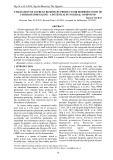
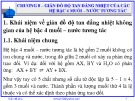

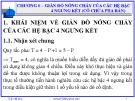
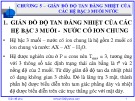
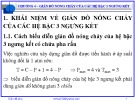
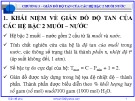
![Bài giảng Giản đồ pha: Chương 2 - Nguyễn Văn Hòa [FULL]](https://cdn.tailieu.vn/images/document/thumbnail/2018/20180409/tieu_vu10/135x160/531523282915.jpg)
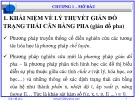






![Bài giảng Chế biến khoáng sản vô cơ [Mới nhất]](https://cdn.tailieu.vn/images/document/thumbnail/2025/20251025/thanhvan173002/135x160/21521761538638.jpg)








